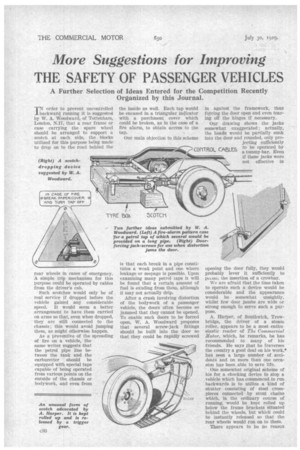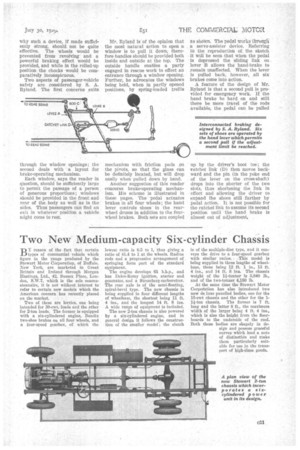More Suggestions for Improving THE SAFETY OF PASSENGER VEHICLES
Page 52

Page 53

If you've noticed an error in this article please click here to report it so we can fix it.
A Further Selection of Ideas Entered for the Competition Recently Organized by this Journal.
IN order to prevent uncontrolled backward running it is suggested by W. A. Woodward, of Tottenham, London, N.17, that a rear frame or case carrying the spare wheel should be arranged to support a scotch at each side, the blocks utilized for this purpose being made to drop on to the road behind the
rear wheels in cases of emergency. A simple trip mechanism for this purpose could be operated by cables from the driver's cab.
Such scotches would only be of real service if dropped before the vehicle gained any considerable speed. It would seem a better arrangement to have them carried on arms so that, even when dropped, they are still connected to the chassis; this would avoid jumping them, as might otherwise happen.
As a preventive of the spreading of tire on a vehicle, the same writer suggests that the petrol pipe line between the tank and the carburetter should he equipped with special taps capable of being operated from various.points on the outside of the chassis or bodywork, and even from the inside as well. Each tap would be encased in a triangular indicator with a parchment cover which could be broken, as in the case of a fire alarm, to obtain access to the tap.
Our main objection to this scheme is that each break in a pipe constitutes a weak point and one where leakage or seepage is possible. Upon examining many petrol taps it will be found that a certain amount of fuel is exuding from them, although it may not actually drip.
After a crash involving distortion of the bodywork of a passenger vehicle, the doors often become so jammed that they cannot be opened. To enable such doors to be forced open, W. A. Woodward proposes that several screw-jack fittings should be built into the door so that they could be rapidly screwed in against the framework, thus forcing the door open and even tearing off the hinges if necessary.
Our drawing shows the jacks somewhat exaggerated ; actually, the heads would be partially sunk into the door and rounded, only projecting sufficiently to be operated by a tommy-bar. Even if these jacks were not effective in
COMROL CABLES
opening the door fully, they would probably lever it sufficiently to p.ainit the insertion of a crowbar.
We are afraid that the time taken to operate such a device would be considerable and the appearance would be somewhat unsightly, whilst few door jambs are wide or strong enough to serve such a purpose.
A. Harper, of Southwick, Trowbridge, the driver of a steam roller, appears to be a most enthusiastic reader of The Commercial Motor, which, he remarks, he has recommended to many of his friends. He says that he fraverses the country a good deal on his work,• has seen a large number Of accidents and on more than one occasion has been able to save life.
One somewhat original scheme of his for a chocking device to stop a vehicle which has commenced to run backwards is to utilize a kind of shutter consisting of steel erosspieces connected by stout chains which, in the ordinary course of running, would be kept rolled up below the frame brackets situated behind the wheels, but which -could be instantly released so that the rear wheels would run on to them.
There appears to be no reason why such a device, if made sufficiently strong, should not be quite effective. The wheels would be prevented from revoliing and a powerful braking effect would be provided, and while in the rolled-up position the chocks would be comparatively inconspicuous.
Two aspects of passenger-vehicle safety are considered by S. A. Ryland, The first concerns exits through the window openings; the second deals with a layout for brake-operating mechanism.
Each window, says the reader in question, should be sufficiently large to permit the passage of a person of generous proportions ; windows should be provided in the front and rear of the . body as well as in the sides. Thus passengers can find an exit in whatever position a vehicle might come to rest.
Mr. Ryland is-of the opinion that the most natural action to open a window is to pull it down, therefore handles should he provided both inside and outside at the top. The outside handle enables a party engaged in rescue work to effect an entrance through a window opening. Further, he advocates the windows being held, when in partly opened positions, by spring-loaded trellis
mechanism with friction pads on the pivots, so that the glass can be definitely located, but will drop easily when pulled down by band.
Another suggestion of this reader concerns brake=operating mechanism. His scheme is illustrated in these pages. The pedal actuates brakes in all four wheels; the hand lever controls shoes' in the rearwheel drums in addition to the fourwheel brakes. Both sets are coupled
as shewn. The pedal works throagli servo-assister device. Referring tO the reproduction of the sketch it will be seen that when the pedal • is depressed the sliding link on lever fl allows the hand-brake to • remain unaffected. When the lever is pulled back, however, all six brakes come into action.
A feature of the design of Mr. Ryland is that a second pull is provided for emergency work. If the hand brake be bard on and still there be more travel of the rods available, the pedal can be pulled
up by the driver's boot toe; the ratchet link (D) then moves backward and the pin (in the yoke end of the lever on the cross-shaft) drops into the shorter of the two slots, thus shortening the link in effect and allowing the driver to expand the shoes still farther by pedal action. It is not possible for the ratchet link to assume its second position until the hand brake is almost out of adjustment.












































































































